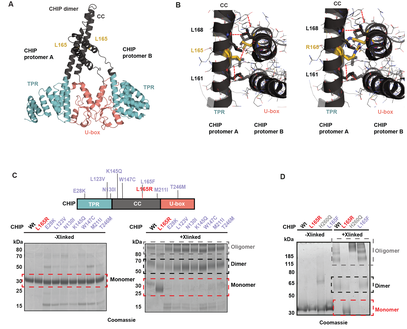Inherited cerebellar ataxias are neurodegenerative diseases characterized by a progressive loss of Purkinje neurons. Cerebellar neurodegeneration results in a variety of symptoms, including decreased muscle control and incoordination, and clinical symptoms that often reflect the anatomical site of damage. Genetic studies identified disease-associated mutations in the ubiquitin ligase CHIP in more than 130 patients. The identified mutations have been linked to autosomal recessive spinocerebellar ataxia SCAR16 and autosomal dominant SCA48. Recent experimental and clinical results suggest that CHIP has a protective role in preventing neurodegeneration. However, despite the neuroprotective activity in degrading aggregation-prone proteins, it is not yet clear how the nature and location of CHIP mutations contribute to the clinical expression of spinocerebellar ataxia and neuronal degeneration. Therefore, the main goal of our research is to understand the pathomechanism by which CHIP mutations cause spinocerebellar ataxia, which could contribute to the therapeutic treatment of neurodegenerative diseases. This proposal uses a multidisciplinary approach that combines protein biochemistry with C. elegans and cell culture approaches to investigate the role of CHIP in SCAR16 and SCA48. The goals of this proposal are to
Neurodegenerative diseases are incurable chronic neurological disorders whose risk increases with age and for which there are no treatments that modify the neurodegenerative process or provide neuroprotection, which is an increasingly important medical and public health issue as life expectancy increases. Understanding the neuroprotective role of the ubiquitin ligase CHIP will be of therapeutic importance for the treatment of numerous neurodegenerative diseases.
Our recent work identified that CHIP regulates the level of the insulin receptor, which is essential for metabolism and organismal health (Tawo et al., 2017). However, little is known about the neuroprotective activity of CHIP and its dysregulation in the context of neurodegenerative diseases. Therefore, the main goal of our research is to understand the pathomechanism by which CHIP mutations cause spinocerebellar ataxia, which could contribute to the therapeutic treatment of various neurodegenerative diseases. This proposal uses a multidisciplinary approach that combines protein biochemistry with C. elegans and cell culture approaches to investigate the role of CHIP in SCAR16 and SCA48. The goals of this proposal are to
Tawo R., Pokrzywa W., Kevei E., Balaji V., Arian S., Höhfeld J.*, Hoppe T.* (2017) Cell 169: 470-482.


Institute for Genetics - Lab. for Proteostasis in Development and Aging - CECAD Research Center
CMMC - PI - C 07
thorsten.hoppe[at]uni-koeln.de
show more…+49 221 478 84218
+49 221 478 7789
Institute for Genetics - Lab. for Proteostasis in Development and Aging - CECAD Research Center
Joseph-Stelzmann-Str. 26
50931 Cologne
Lab Manager
Dr. Alexandra Segref
Office
Karoline Bendig
Kerstin Walfort
Postdocs
Dr. Nikolaos Charmpilas
Dr. André Franz
Dr. Qiaochu Li
Dr. Franziska Ottens
PhD Students
Karen Bauer
Sotirios Efstathiou
Carl Elias Kutzner
Leonie Müller
Andriana Ntogka
Maria Pandrea
Serena Salman
Technicians
Agata Lisowski
Gabriele Stellbrink
Gaby Vopper
Master Students
Isabel Conze
Fuateima Niwa